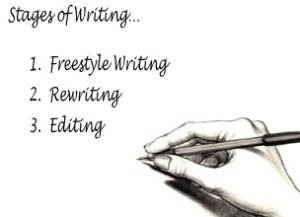 The first thing to learn in the writing journey is that not all writing is the same. There are several types or stages of writing, and each of them requires a certain mindset and set of skills to accomplish them. And just because you’re good at one type of writing, doesn’t make you good at the other types, and making the transitions to each can be difficult to accomplish or there might be difficulty in determining when to make the transition.
The first thing to learn in the writing journey is that not all writing is the same. There are several types or stages of writing, and each of them requires a certain mindset and set of skills to accomplish them. And just because you’re good at one type of writing, doesn’t make you good at the other types, and making the transitions to each can be difficult to accomplish or there might be difficulty in determining when to make the transition.
Freestyle Writing
This is the kind of writing most people assume writers do (but in reality it’s just the first step in a larger process). It’s the fun stuff. The part were you let everything just explode out of your head and onto the page. It’s an everything goes kind of thing where no idea is a bad idea and anything can happen. It can be a most uplifting experience, especially if you’ve done a lot of thinking about the story before ever placing pen to paper. If you’ve been there, you know what I mean. It’s where that thing called a writer’s high happens, and it’s a great place to be!
This writing stage doesn’t require a whole lot of special knowledge. Just an idea of what makes a good story, what makes compelling characters, and how to write a beginning, middle and end of a story. Much of this can be learned simply by being an avid reader, or taking some writing workshops on story structure and character development.
Rewriting
Continue reading “Stages of Writing: Freestyle Writing vs. Rewriting vs. Editing” →
